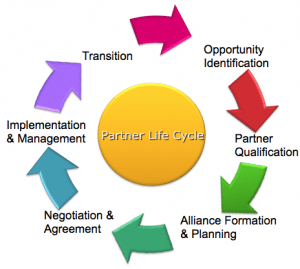This is the text of the September newsletter as distributed earlier this week. When interested to receive the newsletter directly in your inbox please subscribe in the right column.
Partnering nowadays is more and more a tool being used to grow organizations. It can be more cost effective and faster than growing organically or by mergers and acquisitions. Organically will mean that you will have to build up all the required knowledge and do all of the investments yourself. Mergers and acquisitions require substantial investment upfront and a thorough integration process to make it one organization.
Partnerships at first sight may seem easy to some people: you do your thing, your partner does his thing and when you bring it together it magically blends and voila there is your partnership! When I write it down like this it reminds me of a commercial used in the early days of the Senseo coffeemaker: the video commercial shows a a product engineer at Philips who designed a new machine where no longer drip coffee was the recipe but a pad was needed. His management did not approve the idea as there was no pad available. In a second scene it shows a young product manager at Douwe Egberts who came up with an idea of coffee wrapped in pads: easy and without any hassle. Also her management did not approve the idea, after all the pads did not fit into the regular machines available at that time. Then in the next scene these two bumped into each other on the street and all their paperwork fell on the street. While they grabbed together all papers they noticed each other’s ideas and saw the match. They lived happily ever after!
Generally partnerships do not start that way and I can assure you that how entertaining this commercial was, it did not start that way with the Senseo partnership! Like with any other element in business also a partnership needs attention: from the opportunity identification till the partnership transitions into its next stage, or termination. When done right partnerships can be highly successful and profitable.
Over time many organizations have collected the learning from their partnerships and strategic alliances into best practices. These are also the best practices that form the foundation for the certification program of the Association of Strategic Alliance Professionals (ASAP) and as such also the education programs that help prepare for certification.
When looking at these best practices from a high level, they can be summarized in a 6 step alliance- or partner life cycle.  A step for each of the main stages of partnership development and each step consisting of a number of sub-steps. The partner life cycle can best be seen as a toolbox where you will use the most appropriate tools required for the phase of the alliance you are in. Unfortunately many organizations tend to overlook the need for a good preparation and fail to meet the basic steps to successful managing partnerships. The results are unsatisfied partners and failed partnerships and hence wasted investments in time and money. Disappointments that could have been prevented when applying the tools from the partner life cycle.
A step for each of the main stages of partnership development and each step consisting of a number of sub-steps. The partner life cycle can best be seen as a toolbox where you will use the most appropriate tools required for the phase of the alliance you are in. Unfortunately many organizations tend to overlook the need for a good preparation and fail to meet the basic steps to successful managing partnerships. The results are unsatisfied partners and failed partnerships and hence wasted investments in time and money. Disappointments that could have been prevented when applying the tools from the partner life cycle.
How about you, how do you create your partnerships? Do you follow the opportunistic approach and just jump in or rather prefer to build upon the experiences others already captured? Come and join us on the 9th of November in Amsterdam for the full day Alliance Skills Mastery & Best Practices workshop to learn about the full partner life cycle and its applicability for your organization. Or call / email me to discuss: I will be more than happy to share a few critical partnering success factors for your organization.